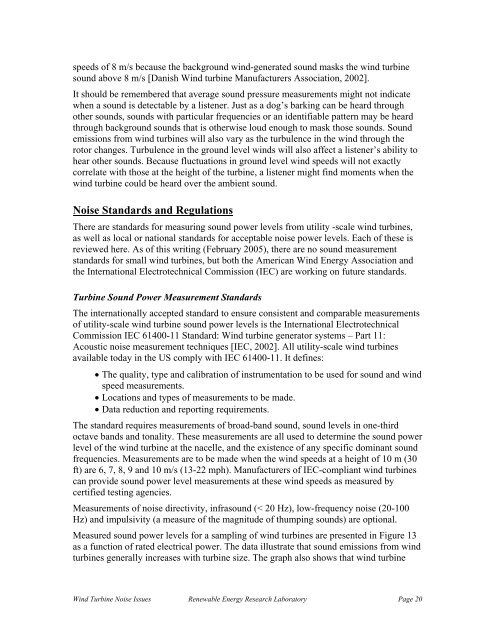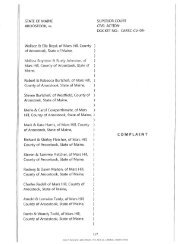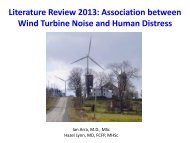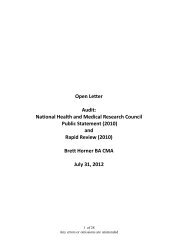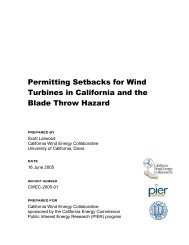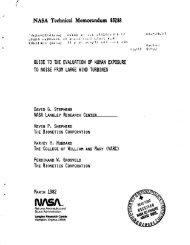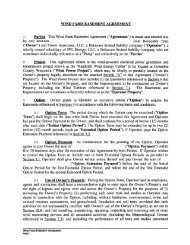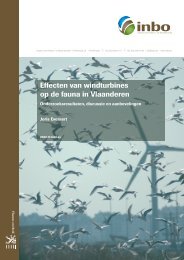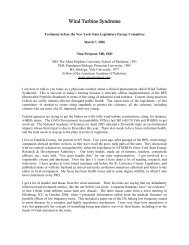Noise White Paper Outline - Minuteman Wind, LLC
Noise White Paper Outline - Minuteman Wind, LLC
Noise White Paper Outline - Minuteman Wind, LLC
Create successful ePaper yourself
Turn your PDF publications into a flip-book with our unique Google optimized e-Paper software.
speeds of 8 m/s because the background wind-generated sound masks the wind turbinesound above 8 m/s [Danish <strong>Wind</strong> turbine Manufacturers Association, 2002].It should be remembered that average sound pressure measurements might not indicatewhen a sound is detectable by a listener. Just as a dog’s barking can be heard throughother sounds, sounds with particular frequencies or an identifiable pattern may be heardthrough background sounds that is otherwise loud enough to mask those sounds. Soundemissions from wind turbines will also vary as the turbulence in the wind through therotor changes. Turbulence in the ground level winds will also affect a listener’s ability tohear other sounds. Because fluctuations in ground level wind speeds will not exactlycorrelate with those at the height of the turbine, a listener might find moments when thewind turbine could be heard over the ambient sound.<strong>Noise</strong> Standards and RegulationsThere are standards for measuring sound power levels from utility -scale wind turbines,as well as local or national standards for acceptable noise power levels. Each of these isreviewed here. As of this writing (February 2005), there are no sound measurementstandards for small wind turbines, but both the American <strong>Wind</strong> Energy Association andthe International Electrotechnical Commission (IEC) are working on future standards.Turbine Sound Power Measurement StandardsThe internationally accepted standard to ensure consistent and comparable measurementsof utility-scale wind turbine sound power levels is the International ElectrotechnicalCommission IEC 61400-11 Standard: <strong>Wind</strong> turbine generator systems – Part 11:Acoustic noise measurement techniques [IEC, 2002]. All utility-scale wind turbinesavailable today in the US comply with IEC 61400-11. It defines:• The quality, type and calibration of instrumentation to be used for sound and windspeed measurements.• Locations and types of measurements to be made.• Data reduction and reporting requirements.The standard requires measurements of broad-band sound, sound levels in one-thirdoctave bands and tonality. These measurements are all used to determine the sound powerlevel of the wind turbine at the nacelle, and the existence of any specific dominant soundfrequencies. Measurements are to be made when the wind speeds at a height of 10 m (30ft) are 6, 7, 8, 9 and 10 m/s (13-22 mph). Manufacturers of IEC-compliant wind turbinescan provide sound power level measurements at these wind speeds as measured bycertified testing agencies.Measurements of noise directivity, infrasound (< 20 Hz), low-frequency noise (20-100Hz) and impulsivity (a measure of the magnitude of thumping sounds) are optional.Measured sound power levels for a sampling of wind turbines are presented in Figure 13as a function of rated electrical power. The data illustrate that sound emissions from windturbines generally increases with turbine size. The graph also shows that wind turbine<strong>Wind</strong> Turbine <strong>Noise</strong> Issues Renewable Energy Research Laboratory Page 20


